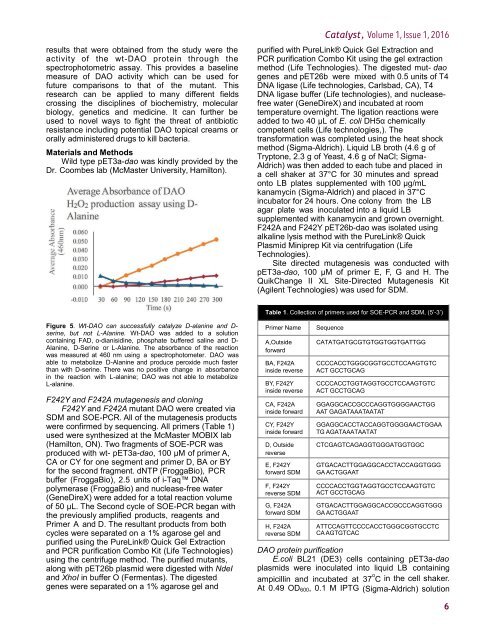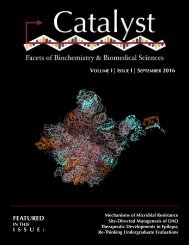Catalyst 2016
You also want an ePaper? Increase the reach of your titles
YUMPU automatically turns print PDFs into web optimized ePapers that Google loves.
esults that were obtained from the study were the<br />
activity of the wt-DAO protein through the<br />
spectrophotometric assay. This provides a baseline<br />
measure of DAO activity which can be used for<br />
future comparisons to that of the mutant. This<br />
research can be applied to many different fields<br />
crossing the disciplines of biochemistry, molecular<br />
biology, genetics and medicine. It can further be<br />
used to novel ways to fight the threat of antibiotic<br />
resistance including potential DAO topical creams or<br />
orally administered drugs to kill bacteria.<br />
Materials and Methods<br />
Wild type pET3a-dao was kindly provided by the<br />
Dr. Coombes lab (McMaster University, Hamilton).<br />
<strong>Catalyst</strong>, Volume 1, Issue 1, <strong>2016</strong><br />
purified with PureLink® Quick Gel Extraction and<br />
PCR purification Combo Kit using the gel extraction<br />
method (Life Technologies). The digested mut- dao<br />
genes and pET26b were mixed with 0.5 units of T4<br />
DNA ligase (Life technologies, Carlsbad, CA), T4<br />
DNA ligase buffer (Life technologies), and nucleasefree<br />
water (GeneDireX) and incubated at room<br />
temperature overnight. The ligation reactions were<br />
added to two 40 µL of E. coli DH5α chemically<br />
competent cells (Life technologies,). The<br />
transformation was completed using the heat shock<br />
method (Sigma-Aldrich). Liquid LB broth (4.6 g of<br />
Tryptone, 2.3 g of Yeast, 4.6 g of NaCl; Sigma-<br />
Aldrich) was then added to each tube and placed in<br />
a cell shaker at 37°C for 30 minutes and spread<br />
onto LB plates supplemented with 100 µg/mL<br />
kanamycin (Sigma-Aldrich) and placed in 37°C<br />
incubator for 24 hours. One colony from the LB<br />
agar plate was inoculated into a liquid LB<br />
supplemented with kanamycin and grown overnight.<br />
F242A and F242Y pET26b-dao was isolated using<br />
alkaline lysis method with the PureLink® Quick<br />
Plasmid Miniprep Kit via centrifugation (Life<br />
Technologies).<br />
Site directed mutagenesis was conducted with<br />
pET3a-dao, 100 µM of primer E, F, G and H. The<br />
QuikChange II XL Site-Directed Mutagenesis Kit<br />
(Agilent Technologies) was used for SDM.<br />
Table 1. Collection of primers used for SOE-PCR and SDM, (5’-3’)<br />
Figure 5. Wt-DAO can successfully catalyze D-alanine and D-<br />
serine, but not L-Alanine. Wt-DAO was added to a solution<br />
containing FAD, o-dianisidine, phosphate buffered saline and D-<br />
Alanine, D-Serine or L-Alanine. The absorbance of the reaction<br />
was measured at 460 nm using a spectrophotometer. DAO was<br />
able to metabolize D-Alanine and produce peroxide much faster<br />
than with D-serine. There was no positive change in absorbance<br />
in the reaction with L-alanine; DAO was not able to metabolize<br />
L-alanine.<br />
F242Y and F242A mutagenesis and cloning<br />
F242Y and F242A mutant DAO were created via<br />
SDM and SOE-PCR. All of the mutagenesis products<br />
were confirmed by sequencing. All primers (Table 1)<br />
used were synthesized at the McMaster MOBIX lab<br />
(Hamilton, ON). Two fragments of SOE-PCR was<br />
produced with wt- pET3a-dao, 100 µM of primer A,<br />
CA or CY for one segment and primer D, BA or BY<br />
for the second fragment. dNTP (FroggaBio), PCR<br />
buffer (FroggaBio), 2.5 units of i-Taq DNA<br />
polymerase (FroggaBio) and nuclease-free water<br />
(GeneDireX) were added for a total reaction volume<br />
of 50 µL. The Second cycle of SOE-PCR began with<br />
the previously amplified products, reagents and<br />
Primer A and D. The resultant products from both<br />
cycles were separated on a 1% agarose gel and<br />
purified using the PureLink® Quick Gel Extraction<br />
and PCR purification Combo Kit (Life Technologies)<br />
using the centrifuge method. The purified mutants,<br />
along with pET26b plasmid were digested with NdeI<br />
and XhoI in buffer O (Fermentas). The digested<br />
genes were separated on a 1% agarose gel and<br />
Primer Name<br />
A,Outside<br />
forward<br />
BA, F242A<br />
inside reverse<br />
BY, F242Y<br />
inside reverse<br />
CA, F242A<br />
inside forward<br />
CY, F242Y<br />
inside forward<br />
D, Outside<br />
reverse<br />
E, F242Y<br />
forward SDM<br />
F, F242Y<br />
reverse SDM<br />
G, F242A<br />
forward SDM<br />
H, F242A<br />
reverse SDM<br />
Sequence<br />
CATATGATGCGTGTGGTGGTGATTGG<br />
CCCCACCTGGGCGGTGCCTCCAAGTGTC<br />
ACT GCCTGCAG<br />
CCCCACCTGGTAGGTGCCTCCAAGTGTC<br />
ACT GCCTGCAG<br />
GGAGGCACCGCCCAGGTGGGGAACTGG<br />
AAT GAGATAAATAATAT<br />
GGAGGCACCTACCAGGTGGGGAACTGGAA<br />
TG AGATAAATAATAT<br />
CTCGAGTCAGAGGTGGGATGGTGGC<br />
GTGACACTTGGAGGCACCTACCAGGTGGG<br />
GA ACTGGAAT<br />
CCCCACCTGGTAGGTGCCTCCAAGTGTC<br />
ACT GCCTGCAG<br />
GTGACACTTGGAGGCACCGCCCAGGTGGG<br />
GA ACTGGAAT<br />
ATTCCAGTTCCCCACCTGGGCGGTGCCTC<br />
CA AGTGTCAC<br />
DAO protein purification<br />
E.coli BL21 (DE3) cells containing pET3a-dao<br />
plasmids were inoculated into liquid LB containing<br />
ampicillin and incubated at 37 o C in the cell shaker.<br />
At 0.49 OD 600 , 0.1 M IPTG (Sigma-Aldrich) solution<br />
6




